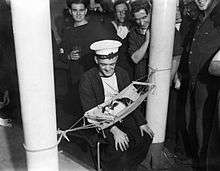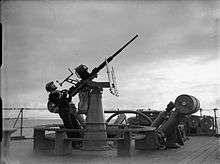HMS Hermione (74)
 Aerial photograph of Hermione at sea, January 1942 | |
| History | |
|---|---|
| Name: | HMS Hermione |
| Builder: | Alexander Stephen and Sons (Glasgow, Scotland) |
| Laid down: | 6 October 1937 |
| Launched: | 18 May 1939 |
| Commissioned: | 25 March 1941 |
| Identification: | Pennant number 74 |
| Fate: | Sunk 16 June 1942 by German submarine U-205 |
| General characteristics | |
| Class and type: | Dido-class light cruiser |
| Displacement: |
|
| Length: |
|
| Beam: | 50.5 ft (15.4 m) |
| Draught: | 14 ft (4.3 m) |
| Propulsion: |
|
| Speed: | 32.25 knots (60 km/h) |
| Range: |
|
| Complement: | 480 |
| Armament: |
|
| Armour: | |
HMS Hermione was a Dido-class light cruiser of the Royal Navy, She was built by Alexander Stephen and Sons, (Glasgow, Scotland), with the keel laid down on 6 October 1937. She was launched on 18 May 1939 and commissioned 25 March 1941. On 16 June 1942, Hermione was torpedoed and sunk by the German submarine U-205 in the Mediterranean. Eighty-seven crewmembers perished.
History

Convoy, Hermione's ship's cat, sleeps in a hammock whilst members of the crew look on

The latest 20 mm Oerlikon gun on board HMS Hermione, showing a naval gunner utilising the rubber shoulder rests for high-angle firing, with the Thornycroft depth charge thrower Mark II and depth charge launching rail in the background.
References
- Colledge, J. J.; Warlow, Ben (2006) [1969]. Ships of the Royal Navy: The Complete Record of all Fighting Ships of the Royal Navy (Rev. ed.). London: Chatham Publishing. ISBN 978-1-86176-281-8. OCLC 67375475.
External links
| Wikimedia Commons has media related to HMS Hermione (74). |
This article is issued from
Wikipedia.
The text is licensed under Creative Commons - Attribution - Sharealike.
Additional terms may apply for the media files.